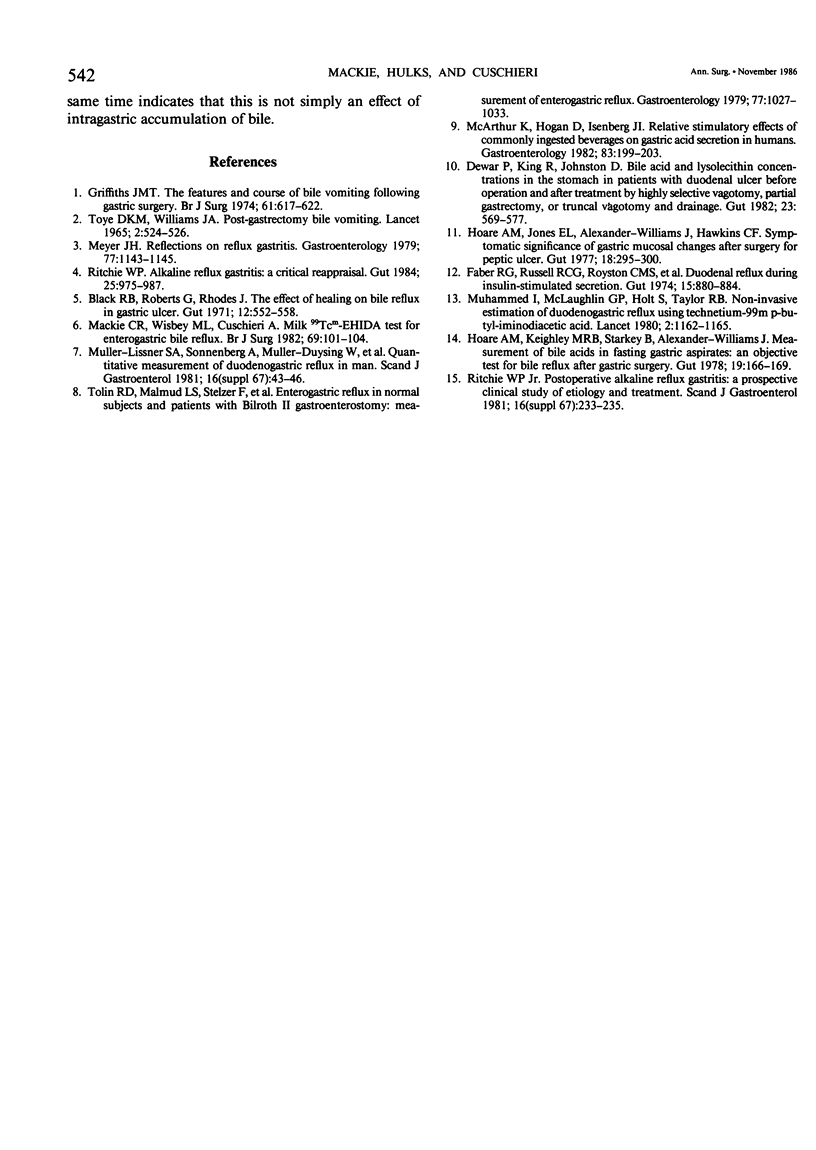Abstract
A noninvasive scintigraphic technique was used to estimate enterogastric reflux and subsequent gastric evacuation of refluxate in 35 normal, healthy subjects and 55 patients previously treated by vagotomy or partial gastrectomy. Reflux was provoked by a milk drink and quantitated by counting 99Tcm-EHIDA activity within the gastric area during gamma camera imaging. Seven normal subjects (20%) showed reflux of 5-18% of initial activity (mean: 10%), with peak values occurring at 5-30 minutes (mean: 14 minutes) following the milk. Gastric evacuation of activity in these subjects was monoexponential (r = 0.993, T1/2 = 24.1 minutes). Reflux occurred more frequently than normal in patients with truncal vagotomy and drainage (22/28 patients) and partial gastrectomy (20/21 patients). All of 16 patients with Billroth II anastomoses exhibited reflux, which was excessive compared with refluxing normal subjects (mean: 25%; p less than 0.01) and occurred later into the study (mean: 34 minutes; p less than 0.01). Ten of 11 asymptomatic patients showed reflux of similar amounts of activity (mean: 21%) compared with 16 patients who complained of bile vomiting (mean: 22%). However, asymptomatic patients exhibited gastric evacuation of refluxate at a rate similar to that of refluxing normal subjects, while bile vomiters showed significant gastric retention of refluxate at 25-30 minutes following peak gastric activity (p less than 0.05). This result confirms that post-operative bile vomiting is essentially a problem of gastric emptying.
Full text
PDF





Selected References
These references are in PubMed. This may not be the complete list of references from this article.
- Black R. B., Roberts G., Rhodes J. The effect of healing on bile reflux in gastric ulcer. Gut. 1971 Jul;12(7):552–558. doi: 10.1136/gut.12.7.552. [DOI] [PMC free article] [PubMed] [Google Scholar]
- Dewar P., King R., Johnston D. Bile acid and lysolecithin concentrations in the stomach in patients with duodenal ulcer before operation and after treatment by highly selective vagotomy, partial gastrectomy, or truncal vagotomy and drainage. Gut. 1982 Jul;23(7):569–577. doi: 10.1136/gut.23.7.569. [DOI] [PMC free article] [PubMed] [Google Scholar]
- Faber R. G., Russell R. C., Royston C. M., Whitfield P., Hobsley M. Duodenal reflux during insulin-stimulated secretion. Gut. 1974 Nov;15(11):880–884. doi: 10.1136/gut.15.11.880. [DOI] [PMC free article] [PubMed] [Google Scholar]
- Griffiths J. M. The features and course of bile vomiting following gastric surgery. Br J Surg. 1974 Aug;61(8):617–622. doi: 10.1002/bjs.1800610807. [DOI] [PubMed] [Google Scholar]
- Hoare A. M., Jones E. L., Alexander-Williams J., Hawkins C. F. Symptomatic significance of gastric mucosal changes after surgery for peptic ulcer. Gut. 1977 Apr;18(4):295–300. doi: 10.1136/gut.18.4.295. [DOI] [PMC free article] [PubMed] [Google Scholar]
- Hoare A. M., Keighley M. R., Starkey B., Alexander-Williams J. Measurement of bile acids in fasting gastric aspirates: an objective test for bile reflux after gastric surgery. Gut. 1978 Mar;19(3):166–169. doi: 10.1136/gut.19.3.166. [DOI] [PMC free article] [PubMed] [Google Scholar]
- Mackie C. R., Wisbey M. L., Cuschieri A. Milk 99Tcm-EHIDA test for enterogastric bile reflux. Br J Surg. 1982 Feb;69(2):101–104. doi: 10.1002/bjs.1800690215. [DOI] [PubMed] [Google Scholar]
- McArthur K., Hogan D., Isenberg J. I. Relative stimulatory effects of commonly ingested beverages on gastric acid secretion in humans. Gastroenterology. 1982 Jul;83(1 Pt 2):199–203. [PubMed] [Google Scholar]
- Meyer J. H. Reflections on reflux gastritis. Gastroenterology. 1979 Nov;77(5):1143–1145. [PubMed] [Google Scholar]
- Muhammed I., McLoughlin G. P., Holt S., Taylor T. V. Non-invasive estimation of duodenogastric reflux using technetium-99m p-butyl-iminodiacetic acid. Lancet. 1980 Nov 29;2(8205):1162–1165. doi: 10.1016/s0140-6736(80)92596-9. [DOI] [PubMed] [Google Scholar]
- Müller-Lissner S. A., Sonnenberg A., Müller-Duysing W., Will N., Heinzel F., Blum A. L. Quantitative measurement of duodenogastric reflux in man. I. Methodology. Scand J Gastroenterol Suppl. 1981;67:43–46. [PubMed] [Google Scholar]
- Ritchie W. P. Alkaline reflux gastritis: a critical reappraisal. Gut. 1984 Sep;25(9):975–987. doi: 10.1136/gut.25.9.975. [DOI] [PMC free article] [PubMed] [Google Scholar]
- Ritchie W. P., Jr Postoperative alkaline reflux gastritis: a prospective clinical study of etiology and treatment. Scand J Gastroenterol Suppl. 1981;67:233–235. [PubMed] [Google Scholar]
- Tolin R. D., Malmud L. S., Stelzer F., Menin R., Makler P. T., Jr, Applegate G., Fisher R. S. Enterogastric reflux in normal subjects and patients with Bilroth II gastroenterostomy. Measurement of enterogastric reflux. Gastroenterology. 1979 Nov;77(5):1027–1033. [PubMed] [Google Scholar]
- Toye D. K., Williams J. A. Post-gastrectomy bile vomiting. Lancet. 1965 Sep 11;2(7411):524–526. doi: 10.1016/s0140-6736(65)91475-3. [DOI] [PubMed] [Google Scholar]


